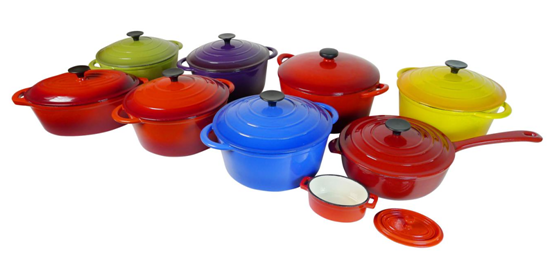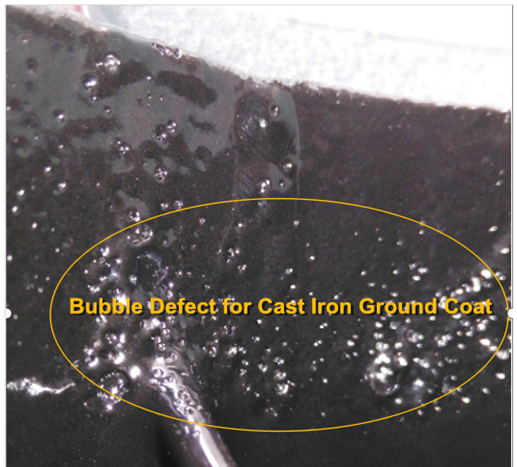How to Avoid Bubble Defect for Cast Iron Enamel
Cast iron enamel products are popular in the market for their beautiful appearance, convenient use and durability. In addition to daily necessities such as cast iron enamel pots, cast iron enamel teapots, etc. it is also very extensive in cast iron pipes, valves, elbows, pump casings and other industrial and agricultural production applications. Enamel coating can greatly extend the service life of the product and increase the added value of the product. However, due to the perforation defects commonly found in cast iron enamel, corrosive media often enter the deep part of the enamel layer through these bubble, and some even reach the metal surface, destroying the stability of the enamel layer, seriously affecting the appearance and intrinsic quality of the product. Therefore, it is necessary to solve the bubble defects of cast iron ground coat.

The main reason for the bubble defects is due to the gas generated by the enamel frit melt , which is affected by the thermal oxidation of the cast iron substrate; the milling additives evaporation, decomposition, oxidation and reduction, and the chemical reaction during the firing (Fe+H2O→FeO+H2↑), metal oxide is affected by carbon reduction. The pores caused by the escape of these gases are still not closed after the enamel frit is sintered, and the bubble defect is formed.

In order to reduce the bubble defects of cast iron enamel, the following requirements should meet for the selection of the cast iron body, the enamel frit selection and the enamel process.
1. Requirements for cast iron body: For enamel cast iron, gray cast iron should be used, and ductile iron can be used, but it is rare. Cast iron that cannot be used for enamel is white cast iron.
2. Requirements for selecting cast iron enamel frit:
a. The viscosity of the cast iron enamel frit should be small. In general, in a certain temperature range, as the temperature increases, the viscosity of the enamel melt decreases, which facilitates the discharge of gas.
b. The softening point of the cast iron enamel frit is low. The cast iron enamel frit should be low temperature frit. Because if the firing temperature is too high, it is easy to decompose the iron carbide in the cast iron into iron oxide and carbon dioxide, so that the porcelain layer forms pores and bubbles. In the softening point and firing temperature range, this stage is favorable for gas discharge due to the small viscosity of the cast iron ground coat.
c. Good gas permeability during the firing process. Before the surface of the cast iron enamel frit is melted, there should always be a certain “gas passage” in the powder layer to allow the gas from the metal surface and the powder layer to escape in time. In order to realize this idea, a certain amount of refractory material such as calcined quartz powder may be added during the enamel frit grinding to cause pores or gaps between the particles to overcome the pores and bubbles generated in the porcelain layer.
d. Good infiltration of enamel frit melt. Better infiltration, ensuring a strong bond between the enamel frit and the metal. The melt has good fluidity, and the attraction between the molecules and the viscosity are small, which are favorable for gas discharge.
e. When the firing is finished, the enamel frit melt should have good sealing properties. After the powder layer is completely melted, the melt should effectively avoid direct impact from the air on the surface of the cast iron, and prevent the carbide from further decomposing and volatilizing in the cast iron. After the gas escapes, the better sealing properties make pores closed, thereby avoiding the creation of "open pores".
f. Pay attention to the adaptability of the enamel frit and the expansion coefficient of the cast iron.
3, The requirements of cast iron enamel process
a, Annealing of cast iron body
Carbon contents and structure in cast iron make big difference on the quality of enamel product. Carbon contains in cast iron exists in both cementite and graphite forms. The free cementite in the cast iron is unstable, and the activated carbon is decomposed during the smoldering, and then the gas is oxidized to cause defects. Therefore, cast iron enamel products should be annealed. Generally speaking, the enamel products that have not been annealed are not as good as annealed ones in appearance, tightness and luster.
b, Surface treatment of cast iron body
The cast iron body should be sanded before coating to remove the dirt on the metal surface. Generally, pickling is not used because the pickling solution and moisture remaining after pickling which is ease to form bubbles during firing.
c, Control of firing temperature and time
The firing temperature of cast iron enamel should not be too high. Generally in the 760~780. The firing time is enough when it’s fully fired that the color of the iron body is match the color in the furnace by visually observe. The firing time is adjusted according to the number and size of the workpiece.
Conclusion from Nolifrit: According to the composition of cast iron and related properties of body, choose relatively fusible cast iron enamel ground coat with low viscosity and good fluidity, use the advantageous mixed ground coat, and appropriate increase grinding amount of quartz powder, to enlarge firing range and increase the space for gas escape, at the same time, annealing, sanding and control the firing temperature and time in strict accordance with the relevant process requirements. The problems of air bubbles, pinholes and other defects in the production of cast iron can be effectively solved.